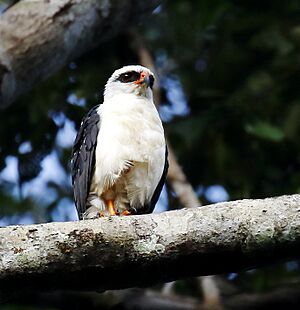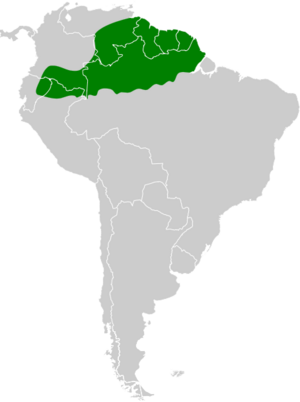Black-faced hawk facts for kids
Quick facts for kids Black-faced hawk |
|
|---|---|
 |
|
| A black-faced hawk in Presidente Figueiredo, Amazonas state, Brazil | |
| Conservation status | |
| Scientific classification | |
| Genus: |
Leucopternis
|
| Species: |
melanops
|
 |
|
The black-faced hawk (Leucopternis melanops) is a cool bird of prey that belongs to the Accipitridae family, which includes hawks, eagles, and kites. For a long time, people thought this hawk only lived north of the Amazon River in the Amazon Basin. But now we know it can also be found south of the river, in places like the Brazilian states of Pará and Acre, and southeastern Peru. It's a bit rare to see, meaning there aren't huge numbers of them around. This hawk is also closely related to the white-browed hawk. Sometimes, you might even see hawks that look like a mix of both species, which means they might sometimes breed together.
Contents
What Does the Black-faced Hawk Look Like?
The black-faced hawk is a medium-sized hawk with striking black and white feathers, called plumage. It has a bright white belly and a large white head. On its head, you'll see some black streaks and a special black "mask" around its eyes. Below this mask, it has a dark orange cere (the waxy part above the beak) and a black-tipped beak.
The back of the hawk is dark, all the way down to its tail. It might have some mottling, which means patches of different shades. A cool feature is a single white band that stands out near the base of its tail.
Young Hawks Look a Bit Different
When black-faced hawks are young, their feathers look a lot like the adults'. However, young hawks have thinner black streaks on their heads. Instead of one white band on their tail, they have two. Also, the tips of their feathers might be a bit brownish.
How to Tell it Apart from Other Hawks
The adult black-faced hawk looks very similar to a young white-browed hawk. Both have white heads with black streaks, a black face mask, and white mottling on their backs. The main way to tell them apart is by their tails. A young white-browed hawk has two white bands on its tail, while an adult black-faced hawk has only one. Also, at any age, the black-faced hawk (L. melanops) usually has more white on its back compared to the white-browed hawk (Leucopternis kuhli).
Where Do Black-faced Hawks Live?
Even though the black-faced hawk is not very common, it lives in many places north of the Amazon River. It's sometimes hard to confirm sightings south of the Amazon because it looks so much like the L. kuhli hawk, which lives there.
But generally, people agree that the black-faced hawk's home range stretches from lowland Peru (north of the Amazon) and northeastern Ecuador all the way to Venezuela, southern Colombia, Brazil (north of the Amazon), and the Guyanas.
Their Favorite Homes
The black-faced hawk loves to live in the tall, lowland forests of the Amazon. You might also spot them at the edges of forests, along rivers, or even in mangrove areas.
How Do Black-faced Hawks Behave?
Black-faced hawks usually like to stay hidden under the forest trees. But because they sometimes hang out near the forest edge, you might see them perching there, especially in the morning.
How They Fly
These hawks haven't been seen soaring high in the sky like some other birds. Instead, they glide for short distances, then flap their wings very fast.
What Do They Sound Like?
The black-faced hawk has a loud, sharp, and downward-sounding whistle. It sounds like "KEEuuu," "KEEler," or "KEEyer." You can even listen to their calls online!
What Do They Eat?
We don't know a lot about what the black-faced hawk eats specifically. However, scientists believe their diet is similar to other hawks in their group, the Leucopternis genus. Most hawks in this group mainly eat snakes and other reptiles. So, it's likely that snakes are a big part of the black-faced hawk's diet too!
How Do They Raise Their Young?
No one has directly watched a black-faced hawk raising its babies yet. But it's thought that they probably act like most other hawks in the Leucopternis group. These raptors build a nest out of sticks high up in the canopy (the top layer) of a tree. Both the mother and father hawk share the job of taking care of the eggs, sitting on them for about five weeks until they hatch.


